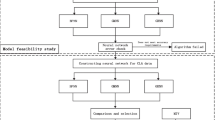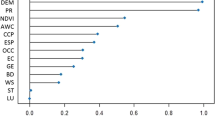Abstract
The left ventricular posterior wall thickness (LVPWT) and interventricular septum thickness (IVST) are generally regarded as the functional parts of the left ventricular (LV) structure. This paper aims to examine the effects of geographical indices on healthy Han adults’ LV structural indices and to offer a scientific basis for developing a unified standard for the reference values of adults’ LV structural indices in China. Fifteen terrain, climate, and soil indices were examined as geographical explanatory variables. Statistical analysis was performed using correlation analysis. Moreover, a back propagation neural network (BPNN) and a support vector regression (SVR) were applied to developing models to predict the values of two indices. After the prediction models were built, distribution maps were produced. The results show that LV structural indices are characteristically associated with latitude, longitude, altitude, average temperature, average wind velocity, topsoil sand fraction, topsoil silt fraction, topsoil organic carbon, and topsoil sodicity. The model test analyses show the BPNN model possesses better simulative and predictive ability in comparison with the SVR model. The distribution maps of the LV structural indices show that, in China, the values are higher in the west and lower in the east. These results demonstrate that the reference values of the adults’ LV structural indices will be different affected by different geographical environment. The reference values of LV structural indices in one region can be calculated by setting up a BPNN, which showed better applicability in this study. The distribution of the reference values of the LV structural indices can be seen clearly on the geographical distribution map.




Similar content being viewed by others
References
Banka VS, Agarwal JB, Bodenheimer MM, et al. (1981) Angiographic assessment of its relative contribution to left and right ventricular contraction. Interventricular septal motion: biventricular angiographic assessment of its relative contribution to left and right ventricular contraction. Circulation 64(5):992–996
Cao XQ, Zhu JG, Tang RY (2005) Soft-sensing technology based on improved BP neural network. Chin J Sci Instrum S1:185–186 (in Chinese)
Chen J, Wu X, Liu DL (2011) The relationship between interventricular septum thickness and carotid intima-media thickness and vascular endothelial function in patients with hypertension. Chin J Hypertens 19(1):71–74 (in Chinese)
Cortes C, Vapnik V (1995) Support-vector networks. Mach Learn 29(3):273–297
Desu RK, Guntuku SC, Aditya B, et al. (2014) Support vector regression based flow stress prediction in austenitic stainless steel 304. Prog Mater Sci 6:368–375
Devereux R (1977) Echocardiographic determination of left ventricular mass in man. Circulation 55:613–618
Devereux RB, Drayer JI, Chien S, et al. (1984) Whole blood viscosity as a determinant of cardiac hypertrophy in systemic hypertension. Am J Cardiol 54(6):592–595
Ding SF, Ye FL (1989) Role of blood viscosity and blood flow velocity in left ventricular hypertrophy in essential hypertension. J Clin Intern Med 3:24–25 (In Chinese)
Garrido C, De Oña R, De Oña J (2014) Neural networks for analyzing service quality in public transportation. Expert Syst Appl 41(15):6830–6838
Ghodsi R, Mirabdollah R, Jalali R, et al. (2012) Predicting wheat production in Iran using an artificial neural networks approach. Int J Acad Restaur Bus Soc Sci 2(2):34
Gradman AH, Alfayoumi F (2006) From left ventricular hypertrophy to congestive heart failure: management of hypertensive heart disease. Prog Cardiovasc Dis 48(5):326–341
Hashiguchi N, Takeda A, Yasuyama Y, et al. (2013) Effects of 6-h exposure to low relative humidity and low air pressure on body fluid loss and blood viscosity. Indoor Air 23(5):430–436
Jin YH, Chen ZM, Liu ZJ, et al. (2010) Characteristic of cardiac remodeling in patients with essential hypertension and polycythemia in high altitude. J Clin Cardiol (China) 26(6):433–435
Kalteh AM (2013) Monthly river flow forecasting using artificial neural network and support vector regression models coupled with wavelet transform. Comput Geosci 54:1–8
Kampus P, Serg M, Kals J, et al. (2011) Differential effects of nebivolol and metoprolol on central aortic pressure and left ventricular wall thickness. Hypertension 57(6):1122–1128
Kansal S, Roitman D, Sheffield LT (1979) Interventricular septal thickness and left ventricular hypertrophy. An echocardiographic study. Circulation 60(5):1058–1065
Kasabov NK (1996) Foundations of neural networks, fuzzy systems and knowledge engineering. MIT Press, Cambridge
Li ZH, Chen XX, Fu Q, et al. (2006) The relationship between left ventricular hypertrophy and blood viscosity in patients with essential hypertension. Qiqihar Med Univ J 27(13):1554–1555 (in Chinese)
Mubiru J (2011) Using artificial neural networks to predict direct solar irradiation. Adv Artif Neural Syst 12
Naeije R (2010) Physiological adaptation of the cardiovascular system to high altitude. Prog Cardiovasc Dis 52(6):456–466
Peterson LR, Waggoner AD, Schechtman KB, et al. (2004) Alterations in left ventricular structure and function in young healthy obese women: assessment by echocardiography and tissue Doppler imaging. J Am Coll Cardiol 43(8):1399–1404
Pluim BM, Zwinderman AH, Vander Laarse A, et al. (2000) The athlete’s heart a meta-analysis of cardiac structure and function. Circulation 101(3):336–344
Qiu XX (2009) The influence of plateau environment on cardiac function. Guizhou Sport Sci Tech 2:33–35 (in Chinese)
Roman MJ, Ganau A, Saba PS, et al. (2000) Impact of arterial stiffening on left ventricular structure. Hypertension 36(4):489–494
Rumelhart DE, Hinton GE, Williams RJ (1986) Learning representations by back-propagating errors. Nature 323:533–536
Tobler WR (1970) A computer movie simulating urban growth in the Detroit region. Econ Geogr 46(2):234–240
Toros H, Deniz A, Şaylan L, et al. (2005) Spatial variability of chilling temperature in Turkey and its effect on human comfort. Meteorog Atmos Phys 88(1):107–118
Tuller SE (1997) Climatic controls of the cool human thermal sensation in a summertime onshore wind. Int J Biometeorol 41(1):26–33
Verdecchia P, Schillaci G, Guerrieri M, et al. (1990) Circadian blood pressure changes and left ventricular hypertrophy in essential hypertension. Circulation 81(2):528–536
Vertilus SM (2010) Echocardiographic manifestations of glycogen storage disease III: increase in wall thickness and left ventricular mass over time. Genet Med Off J Am Coll Med Genet 12(7):413–423
Wang Y, Chen H, Ran W (2013) Association of arterial structure and endothelial function with intervcntricular septum thickness in healthy subject. Int Med Health Guid News 18(19):2808–2810 (in Chinese)
Wauters M, Vanhoucke M (2014) Support vector machine regression for project forecasting. Autom Constr 47:92–106
Wong CY, O’Moore-Sullivan T, Leano R, et al. (2004) Alterations of left ventricular myocardial characteristics associated with obesity. Circulation 110(19):3081–3087
Wu YH, Xiao R, Tang SX, et al. (2013) Changes of the cardiac structure and function in Han people returning to the plain for at least 3 years after long-term exposure to high altitude. Mod Prev Med 40(17):3162–3165 (in Chinese)
Zannad F, Voisin P, Brunotte F, et al. (1988) Haemorheological abnormalities in arterial hypertension and their relation to cardiac hypertrophy. J Hypertens 6(4):293–297
Zhou M, Nie M (2013) Application of the Spectrum peak positioning technology based on BP neural network in demodulation of cavity length of EFPI fiber optical sensor. J Comput Commun 1(7):67
Zhou Q (2014) Changes of the cardiac structure and function in Han people returning to the plain for at least 3 years after long-term exposure to high altitude. Cardiovasc Res 103(suppl 1):S83–S84
Zhou Q, Cao ZC, Chen ZG (2005) Correlation of left ventricular geometry with insulin resistance in elderly patients with essential hypertension. Chin J Geriatr 24(10):729–732 (in Chinese)
Acknowledgments
Project 40971060 supported by the National Nature Science Foundation of China and No. GK201504015 supported by Central College Fund.
Authors’ contributions
MYC performed the statistical analyses and acquired and interpreted the data. GM conceived of the study and carried out the design of the study. YLL, CXW, and SFY helped to revise the manuscript. All authors have read and approved the final manuscript.
Author information
Authors and Affiliations
Corresponding author
Ethics declarations
Conflict of interest
The authors declare that they have no competing interests.
Electronic supplementary material
ESM 1
(DOCX 53 kb)
Rights and permissions
About this article
Cite this article
Cen, M., Ge, M., Liu, Y. et al. The effect of geographical indices on left ventricular structure in healthy Han Chinese population. Int J Biometeorol 61, 303–311 (2017). https://doi.org/10.1007/s00484-016-1212-1
Received:
Revised:
Accepted:
Published:
Issue Date:
DOI: https://doi.org/10.1007/s00484-016-1212-1




